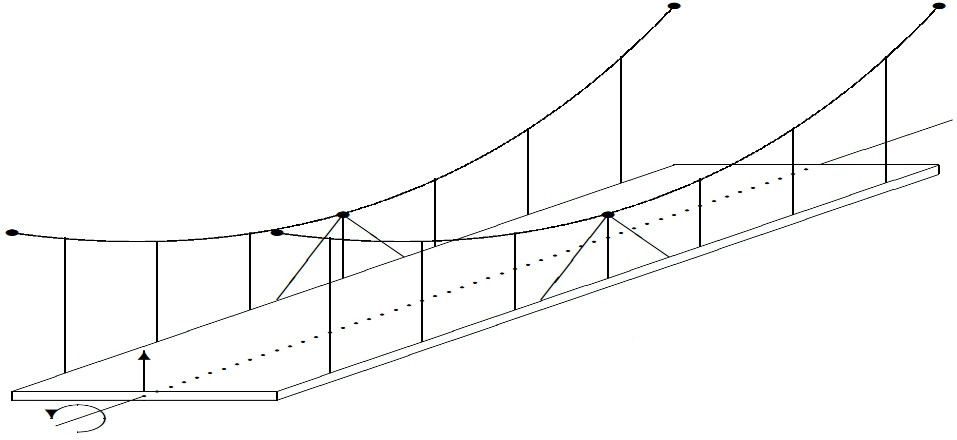Department of applied mathematics and computer science
& Department IT4Innovations
| Prof. RNDr. Radim Blaheta, CSc. | ||
| Prof. Dr. Owe Axelsson Ing. Michal Beres Ing. Martin Cermak, Ph.D. Ing. Simona Domesova Ing. Martin Hasal Prof. Ing. Jaroslav Haslinger, DrSc. Doc. Ing. David Horak, Ph.D. | RNDr. Ondrej Jakl, CSc. RNDr. Roman Kohut, CSc. Mgr. Alexej Kolcun, CSc. Ing. Karel Krecmer Bc. Jakub Kruzik RNDr. Tomas Ligursky, Ph.D. Ing. Tomas Luber | Doc. RNDr. Josef Malik, CSc. Ing. Zdenek Michalec Ing. Marek Pecha Ing. Jiri Stary, Ph.D. Mgr. Stanislav Sysala, Ph.D. Mgr. Dagmar Sysalova |
The history of departments goes back up to the very beginning of the existence of the institute, as its concept already included the idea of development of tools for mathematical modelling. It was the reason for employment of the first mathematicians – Z. Dostal (1978), R. Blaheta and R. Kohut (1979), who started to work already in time when Ostrava branch was just an affiliate of Prague’s institutes. The task was to develop a software for modelling problems of geomechanics and the transfer of heat. Finite element method (FEM), including the development of an in-house software GEM (Geo-FEM) and a special focus on solving large-scale problems of geomechanics became for a long time the main topic of the research. It led to the development of several generations of the GEM software as well as to new iterative methods (use of aggregations, displacement decomposition preconditioners, precon-ditioning by projector, etc.). The initial period was very fruitful and resulted in two unique software - GEM2 for the solution of 2D problems on desktop computer and GEM3, which, owing to iterative solvers, enable to solve large-scale 3D problems. Many applications of this software were done, and moreover, fundamental results in iterative methods were obtained.
The initial research group has gradually enlarged to the Laboratory of mathematical modelling and later, in the nineties, to the Department of Applied Mathematics. In the nineties, an important issue was the involvement in two European projects High Performance Computing in Geosciences I and II, which led to a further development of iterative methods and the use of parallel computations, which now become the basis for the partnership in the IT4Innovations supercomputing project. The first article with parallel computing was published already in 1996 (elasticity problem, parallelization through displacement decomposition, solution on the cluster of three IBM RS/6000 workstations at the institute). In the nineties, the research also concerned the field of nonlinear mechanics and corresponding iterative solvers, modelling of rock bolt reinforcement by energy formulation, and other topics.



The recent research is described in more detail below. Let us only remind, that since 2006 the institute’s organizational structure involves the Department of Applied Mathematics and Computer Science, since 2011 also a new Department IT4Innovations, which was created due to partnership in the already mentioned eponymous project of Centre of Excellence. The departments comprise now eleven research workers (including three PhD students). Since 2005, a team member is also Professor O. Axelsson, whose worldwide recognition is confirmed by the selection to a prestigious list of Highly Cited Researchers from Thomson Reuters (Web of Knowledge).
Main research topics
The research topics in the period 2006 - 2011 came from the research plan of the institute, nowadays they follow a strategic conception of the institute development and the research plan of the IT4Innovations project. This focus includes several research areas.
The numerical modelling of processes in rocks remains as a main research topic. It includes thermal (T), hydraulic (H) and mechanical (M) processes, which are examined both separately and with considering mutual couplings (multiphysics, THM processes). This modelling also covers development of numerical methods and powerful solvers that allow solution to large-scale and demanding problems and comprises modelling of nonlinear processes, the mechanical behaviour of geomaterials behind the failure limit and analysis and reduction of the influence of uncertainties in input data.
From other topics, let us mention the solution to inverse problems for determination of material parameters or rock stress components and the solution to problems of micro-geomechanics with applications to investigation of geocomposites. In the micro-geomechanics, we use the description of inner structure obtained by tomography, the solved problems are characterized by heterogeneity, the multiscale approach and high computational requirements.
A specific area is modelling of reinforcement and geotechnical elements (anchors, geotextiles), geobags, modelling and analysis of the stability behaviour of cable stayed and suspension bridges.
The described research orientation has a high potential for analysis of the problems in development of technologies for the earth's crust utilization and for cooperation with other departments. It also provides a number of impulses for research in mathematical analysis, numerical mathematics, applied computer science, in the areas of optimization of computer programs, parallelization of computing, computer graphics, development of efficient methods for the preparation of models and the visualization of the computed physical fields.
Main research results
The main results concern the numerical modelling of THM processes including the use of methods of Continuum Damage Mechanics, inverse problems, problems of micromechanics and homogenization, modelling and analysis geotubes and analysis of suspended and cable-stayed bridges. More details are omitted due to a limited extent of this publication. The results can be described from the point of view of contribution to mathematics and in terms of benefits and the potential for applications. This latter application view will be preferred.
Modelling of THM processes in rocks, multiphysics. The in-house software GEM is used for modelling of thermo-mechanical processes and development of numerical methods. It was used for solving a number of large-scale problems with millions of degrees of freedom. Originally, the solution concerned only the problems of geomechanics, newly thermo-mechanics analysis is used with applications in problems of underground disposal of the spent nuclear fuel. Solution to extremely large problems is possible by using of our own research in the field of iterative solution methods and parallel computing.
Development of the own software. The GEM software was recently used within the international project Decovalex 2011 for the analysis of processes related to in-situ experiment APSE (Äspö Pillar Stability Experiment) performed in the underground laboratory in Sweden and focused on damage of crystalline granite rocks. Here the concern was first oriented to the stress development related to the construction of underground openings and subsequently to the stress increase due to rock mass heating. The global stress development was complemented by detailed modelling of pillar damage by the methods of Continuum Damage Mechanics (CDM).
Owing APSE, the GEM software was also completed by inverse analysis techniques, both to determine the initial stress components by measuring the deformation (convergence) in a driven tunnel, and identification of heat transport parameters of rocks based on the monitored temperature development.
Another new area of GEM software utilization is micro-geomechanics with an opportunity to input the CT scanner data of heterogeneous structure and to perform detailed analysis of processes and analysis of homogenized behaviour of materials.
The software efficiency is provided by the development of numerical methods and parallel computing. Currently, a parallel system at the institute is used and many calculations were made also in the UPPMAX center of Uppsala University due to joint project, but it is also a preparation for the use of supercomputing technology of IT4Innovations project and the use of advanced software libraries (currently TRILINOS library of Sandia Nat. Lab.).
Iterative solvers. GEM solvers are based on the preconditioners with displacement decomposition, incomplete factorization, domain decomposition by Schwarz method and using of an approximation by aggregation. Parallel implementation is done by using MPI and OpenMP tools.
Recently, also preconditioners exploiting the structure of problems are developed with application to hierarchical discretization, mixed formulation, multiphysics and more. These works also address the modelling of flow in the rock environment, which is a new orientation and a needed extension of research interests for the future.
In addition to iterative techniques for solving large systems of linear problems, the research also concerns methods for solving nonlinear problems, Newton's method for (semismooth) problems appearing in plasticity and damage mechanics, etc.
Multiscale problems, homogenization techniques. Different scales appear in geotechnical engineering from fine heterogeneity of grains, microcracks and fills, through the dimensions of tunnels, faces and constructions, to large-scale and regional dimensions appearing in subsidence due to mining or some groundwater flow problems. Such problems should be solved by gradual analysis with determination of how finer structure affects the coarser scale behaviour (upscaling) and vice versa. Currently, a high attention is paid to this type of problems. In our case, we have developed a method for testing of digital samples with the structure described by means of computer tomography. The testing uses different types of loading, meets mathematically founded estimates, solves large 3D problems with the need of iterative methods that are robust with respect to heterogeneity and jumps in the local material properties.
The homogenization methods were implemented in the GEM software, calibrated and used e.g. for the analysis of coal geocomposites arising in coal seam grouting.
Inverse problems. Inverse analysis aims to identify material and other parameters of the solved problems, which are in standard use of the finite element method (solving the forward problem) considered as known input parameters. The identification of unknown parameters is possible due to using (partial) knowledge of the solution of the direct problem.
We used the inverse analysis for investigation of APSE (Aspo Pillar Stability Experiment) within the Decovalex project for improving the knowledge of the initial stress and thermal properties of the rock mass. The partial knowledge of the direct problem solution was represented here by measured temperature during rock mass heating and convergence of selected points on the access tunnel wall during the tunnel construction. Inverse analysis was also used for determination of the local parameters (elasticity modules) of geocomposites.
The analysis of suspension bridges. Suspension bridges are modelled as one-dimensional beams suspended by a cable system. The cable system consists of main and vertical cables, which are modelled as flexible and absolutely non-extensible one-dimensional objects. The main attention is paid to issues of instability under the dynamic action of wind and study of issues related to the structure of the spectrum of vertical and torsional oscillations of the deck and their influence on the stability in the case of crosswind. The results are applied to the explanation of some serious accidents of the suspension bridges.
Modelling of geosynthetic tubes. Geosynthetic tubes are objects made from special synthetic materials whose length is theoretically unlimited. They are usually filled with water, sand or mud.
We analysed a 2D tube model, which describes the tube shape, the pressure conditions inside the filler material and the stress conditions in the synthetic fabric, from which the tube is made. The analytical model and equations were also formulated for tubes filled with liquids of different specific densities.
Other information
|
Recently solved projects ( PDF, 207 kB )
Selected publications ( PDF, 419 kB ) |
Solved problems and parallel computer systems |









